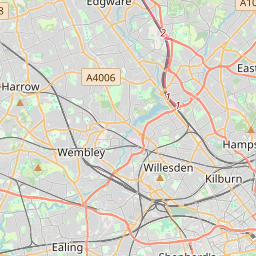Inscription
The London Wall Walk follows the line of the City Wall from the Tower of London to the Museum of London. The Walk is 1¾ miles (2.8km) long and is marked by twenty-one panels which can be followed in either direction. The City Wall was built by the Romans c AD 200. During the Saxon period it fell into decay. From the 12th to 17th centuries large sections of the Roman Wall and gates were repaired or rebuilt. From the 17th century, as London expanded rapidly in size, the Wall was no longer necessary for defence. During the 18th century demolition of parts of the Wall began, and by the 19th century most of the Wall had disappeared. Only recently have several sections again become visible.
West Gate of Roman Fort
Prior to the construction of the western section of the road London Wall in 1959, excavations revealed the west gate of the Roman fort, built c AD 120. It had twin entrance ways flanked on either side by square towers.
Only the northern tower can now be seen. It provided a guardroom and access to the sentry walk along the Wall. Large blocks of sandstone formed the base, some weighing over half a ton (500kg). The remaining masonry consisted of ragstone brought from Kent. The guardroom opened on to a gravel road, which was divided into two by stone piers supporting the arches spanning the gates.
Each passage was wide enough for a cart and had a pair of heavy wooden doors.
Running northwards from the gate-tower is the fort wall, 4 feet (1.2m) thick with the internal thickening added when the fort was incorporated into the Roman city defences c AD 200. The gate was eventually blocked, probably in the troubled years of the later 4th century. By the medieval period the site of the gate had been completely forgotten.
West Gate of Roman Fort
Prior to the construction of the western section of the road London Wall in 1959, excavations revealed the west gate of the Roman fort, built c AD 120. It had twin entrance ways flanked on either side by square towers.
Only the northern tower can now be seen. It provided a guardroom and access to the sentry walk along the Wall. Large blocks of sandstone formed the base, some weighing over half a ton (500kg). The remaining masonry consisted of ragstone brought from Kent. The guardroom opened on to a gravel road, which was divided into two by stone piers supporting the arches spanning the gates.
Each passage was wide enough for a cart and had a pair of heavy wooden doors.
Running northwards from the gate-tower is the fort wall, 4 feet (1.2m) thick with the internal thickening added when the fort was incorporated into the Roman city defences c AD 200. The gate was eventually blocked, probably in the troubled years of the later 4th century. By the medieval period the site of the gate had been completely forgotten.
Details
| HM Number | HM282M |
|---|---|
| Tags | |
| Marker Condition | No reports yet |
| Date Added | Sunday, June 3rd, 2018 at 10:04am PDT -07:00 |
Pictures
Locationbig map





| UTM (WGS84 Datum) | 30U E 701529 N 5711392 |
|---|---|
| Decimal Degrees | 51.51765000, -0.09525000 |
| Degrees and Decimal Minutes | N 51° 31.059', W 0° 5.715' |
| Degrees, Minutes and Seconds | 51° 31' 3.5400000000001" N, 0° 5' 42.9" W |
| Driving Directions | Google Maps |
| Which side of the road? | Marker is on the right when traveling West |
| Closest Postal Address | At or near A1211, London England EC2V 5DY, GB |
| Alternative Maps | Google Maps, MapQuest, Bing Maps, Yahoo Maps, MSR Maps, OpenCycleMap, MyTopo Maps, OpenStreetMap |
Is this marker missing? Are the coordinates wrong? Do you have additional information that you would like to share with us? If so, check in.
Nearby Markersshow on map
Maintenance Issues
- Is this marker part of a series?
- What historical period does the marker represent?
- What historical place does the marker represent?
- What type of marker is it?
- What class is the marker?
- What style is the marker?
- Does the marker have a number?
- What year was the marker erected?
- Who or what organization placed the marker?
- This marker needs at least one picture.
- Can this marker be seen from the road?
- Is the marker in the median?

Comments 0 comments